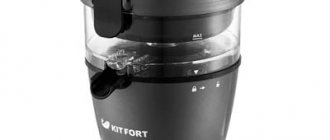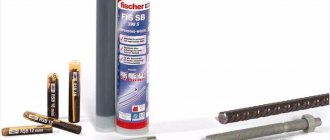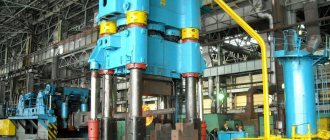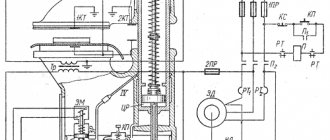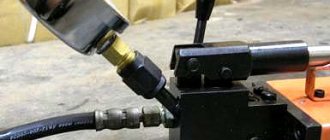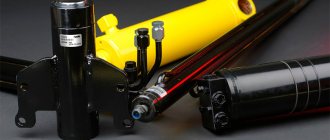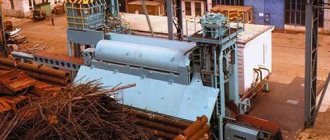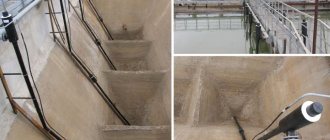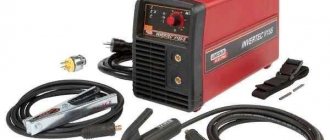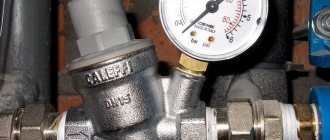The hydraulic cylinder, present in the equipment of many technical devices for both industrial and domestic purposes, is a reciprocating motor, the moving unit of which can be its rod or housing. Thus, a hydraulic cylinder for a press acts as a mechanism that drives the main working body of such equipment - the mold. With relatively small dimensions, hydraulic cylinders are capable of creating forces measured in tens of tons. In this regard, today it is difficult to find a manufacturing enterprise that is not equipped with presses driven by such effective mechanisms.
The main hydraulic cylinder of a metal baling press is capable of developing a force of up to 31,500 kN
Areas of application
If we talk about the most common area of application of hydraulic cylinders, then it is equipping presses for various purposes. Presses, the driving element of which is a hydraulic cylinder, are actively used in enterprises involved in the processing of agricultural products, in metallurgical and machine-building enterprises, as well as in many other areas.
Presses equipped with hydraulic cylinders of various capacities are successfully used to solve the following problems:
- pressing and pressing out bearings and various shafts;
- metal bending and cutting;
- gluing products from various materials, performed under pressure;
- extracting oil and juice from vegetable raw materials.
The working element of this manual crimping of tips is a hydraulic cylinder
Presses equipped with hydraulic cylinders are actively used not only in manufacturing enterprises, but also in everyday life (in particular, for squeezing juices from fruit and berry raw materials, as well as for solving problems of repairing automobiles and any other equipment). Many home craftsmen make such presses with their own hands, using a car jack as the main working body, which, in fact, is a typical hydraulic cylinder capable of developing quite serious forces - up to 50 tons or more.
Depending on the purpose of the press, hydraulic cylinders with the appropriate technical characteristics are selected to equip it. The main characteristics are the operating pressure and the speed at which the plunger moves.
The hydraulic cylinder of this tabletop press is driven by a manual pump station
What is needed to make a press
The drawings of such a device allow you to make a press from a jack with your own hands. They are easy to find on the Internet in the public domain.
Drawing of a homemade press from a hydraulic jack
To make a hydraulic press from a jack, you should also prepare:
- the hydraulic jack itself is of a single-rod bottle type (for a press that will be used at home, a jack that develops a force of up to 10 tons is also suitable);
- inverter with a set of electrodes;
- hacksaw for metal;
- grinder with a set of discs designed for cutting metal;
- a section of channel size 8 and above, 4 m long;
- square or rectangular profile pipe with thick walls;
- equal-flange metal corner No. 50;
- steel strip having a thickness of more than 10 mm;
- a piece of pipe 10–15 mm long, the diameter of which should match the size of the jacking rod;
- metal plate measuring 25x10 cm and thickness 9–10 mm;
- two springs that are needed to return the stop to its original position (springs from car seats, doors, etc. are suitable).
Channel blanks
Operating principle
The principle of operation of a hydraulic cylinder is based on two laws of physics. One of them states that a liquid under pressure practically does not change in its volume. According to the second (Pascal's law), a fluid on which pressure is applied transmits it without changes to any point and in all directions.
Thus, if you create a closed hydraulic system, the elements of which are two cylinders of different diameters, equipped with pistons and connected to each other by a pipeline, the liquid pumped through the pipeline by the piston of a cylinder of a smaller diameter into a cylinder with a piston of a larger diameter will exert greater pressure on the latter. All hydraulic cylinders, which are essentially hydraulic gearboxes, operate according to this scheme.
Piston hydraulic cylinder device
Hydraulic cylinders for equipping presses are distinguished not only by their simplicity of design, but also by other advantages:
- high efficiency demonstrated when working with heavy loads;
- the ability to make precise settings of operating parameters;
- high reliability and protection from overloads, which is ensured by the use of safety valves in the design;
- compact dimensions and light weight;
- high energy efficiency, which ensures cost-effective use of such devices.
Blueprints
Before starting work on creating a hydraulic press, it is strongly recommended to draw up a drawing. The dimensions of all parts of the structure must completely coincide, otherwise the first time you use the unit, the structure will move to the side.
Experts recommend that you independently draw up a drawing of the future system, since ready-made options will not always satisfy the owner in terms of dimensions, and you can also make a mistake in choosing the type of jack. In this case, a lot of time will be lost to adjust the system to its parameters.
Photos of hydraulic press drawings can be easily found on the Internet.
Step-by-step instructions for creating your own hydraulic pressing equipment.
One of the main actions associated with making a hydraulic press with your own hands is preparing the frame. It has the name “bed” and it is inside it that the future press will be located. Its strength must have some reserve, since the pressure inside the frame is carried out in both directions (up and down), so there is a possibility that the frame will break.
The first thing you need to do is cut all the main parts of the structure according to the drawing data. You need to drill holes in the structure. Next, a special plate is installed by welding.
Design features of systems based on hydraulic cylinders
Technical systems, the functioning of which is ensured by a hydraulic cylinder, consist of the following elements:
- hydraulic cylinder;
- hydraulic motor;
- pump;
- emergency valve;
- container containing the working fluid.
Hydraulic diagram of the press (simplified)
The hydraulic cylinder itself consists of the following structural elements:
- housings;
- a piston rigidly connected to the rod;
- block cover, which is equipped with hydraulic equipment that allows you to control the operating parameters of the device.
The performance of a hydraulic cylinder-based system depends on a number of parameters:
- pressure level of the working fluid pumped by the pump;
- diameter of the piston working surface;
- volume of the working chamber of the device.
Hydraulic cylinders with flange mounting on the head side
The characteristics of the working fluid used are of great importance for the efficiency of the hydraulic cylinder:
- chemical composition and density;
- temperature limits at which the working fluid retains its original qualities;
- tendency to develop oxidative processes.
An important quality of the working fluid for a hydraulic cylinder, which you should pay attention to when choosing it, is the ability to retain its original characteristics when in contact with water (water can enter the hydraulic system from the outside).
As practice shows, in 70% of cases of hydraulic cylinder failure or incorrect operation, low-quality working fluid is used for the device. The result is increased wear of individual elements of the hydraulic system, the development of corrosion on the surfaces of metal elements, an increase in oil viscosity, its clogging with dust or dirt, and the appearance of water and air in its composition. Naturally, all such situations, the occurrence and development of which should be avoided, negatively affect the performance of the hydraulic system itself and its elements.
Types of hydraulic cylinders
Hydraulic cylinders for presses are divided into different types according to a number of parameters. Thus, depending on the direction of influence exerted by hydraulic cylinders, they can be classified as single-acting or double-acting devices. According to design they are distinguished:
- piston type devices;
- plunger hydraulic cylinders;
- telescopic hydraulic cylinders.
Schemes of hydraulic cylinders of various types
Not only the design of the hydraulic cylinder may differ, but also the method of its installation on the press it serves. So, depending on this parameter, the hydraulic cylinder can be rigidly fixed or hinged.
In single-acting hydraulic cylinders, in full accordance with their name, the force created is applied to their working body, which can be a piston or plunger, in only one direction. The movement of this element of the hydraulic cylinder in the opposite direction is ensured by the action of gravity, the use of a spring, or the use of an additional hydraulic cylinder.
Hydraulic cylinder with hydraulic lock
When using single-acting hydraulic cylinders for presses complete with a return spring, it should be borne in mind that the force created during the forward stroke of the plunger or piston will be less than that generated by a similar-sized double-acting device. This is explained by the fact that part of the force is spent on overcoming the elastic force of the spring element.
The design of double-sided hydraulic cylinders for presses provides for the use of a working body with two working planes, which allows the use of such a device to apply force in two directions. When connecting to the hydraulic system, it should be kept in mind that one part of the cylinder is connected to the discharge valve, and the second to the waste valve.
Design of a hydraulic cylinder with two piston groups located oppositely
When using double-sided hydraulic cylinders for presses, one should also take into account the fact that the force they create during forward movement of the piston is greater, while its speed of movement is less than during reverse movement. This is explained by the difference in the working areas of the piston from the side of the rod and from the side of its upper part, on which, accordingly, pressure of different magnitudes is exerted.
Telescopic hydraulic cylinders are rarely used to equip a press. Devices of this type are used in cases where it is necessary that the overhang of the hydraulic cylinder rod exceed the length of its body. Such hydraulic cylinders are devices consisting of several cylinders nested one inside the other, with the body of each subsequent cylinder acting as a rod of the previous one. Depending on the direction of action, such hydraulic cylinders can also be single- or double-sided. Most often, telescopic hydraulic cylinders are used to equip cargo vehicles and lifting equipment.
Hydraulic cylinder for press with the possibility of installing a pressure gauge
Manufacturing process
Press frame
The material for the frame, its structural strength and the method of assembly should be determined by the pressure that the jack is capable of delivering. For accurate calculations, it is important to understand in which direction the loads act during operation.
The base of the press is a rectangular U-shaped frame made of a channel or a paired steel angle. The main acting force is the resistance to compression, expressed in concentrated load. The main force is concentrated in the centers of the horizontal crossbars. The forces that stretch the vertical racks of the press and the phenomena of deformation in compressed parts can be completely neglected.
1 - upper thrust beam; 2 - bolts; 3 - jack 20 t; 4 — return springs; 5 - movable beam; 6 — locking pin; 7 - adjustable support beam; 8 - transverse beam; 9 - legs from corners
For installation with a compressive force of up to 5 tons, you can safely use the following to make a frame:
- Channel according to GOST 8240–89, standard size 8P.
- A pair of hot-rolled angles according to GOST 8509–93, size 50x5 mm, connected with 10 mm rods every 20–25 cm, or with a solid weld.
Channel dimensions 8P
Let us immediately make a reservation that we provide approximate data on rolled metal for a frame with an internal window no wider than 100 cm. By analogy, when using a jack with a force of up to 10 tons, the frame should be made from:
- Channel size 10P.
- Twin angle steel 63x7 mm, solid seam connection with internal inserts of nominal cross-section.
Channel dimensions 10P
If the required compression force reaches 15 tons or higher, then the frame should be made of:
- Channel size 14P.
- Twin angle 75x8 mm, connection similar to the previous one.
Channel dimensions 14P
The above proposal for rolled metal products implies a tenfold safety margin, which completely eliminates exceeding the limit of elastic deformation and is normal for installations of this kind. All frame joints must be welded with solid double-sided seams and butt cut. If the connection is not made by welding, assembly with bolts or cotter pins is allowed. In this case, it is necessary to take into account the maximum permissible shear load.
With a bolted connection, the main load becomes dispersed and the compression force of the press must be divided by the number of bolts or pins. The destructive shear force of bolts made of the most common steel ST-3 is:
- M10 - about 2500–3000 kg.
- M12 - 4000–4500 kg.
- M14 - 5500–6000 kg.
To ensure the required safety margin, each fastening element must experience a load five times less than the destructive load. For steel fingers, the force can be taken 10–15% higher than the specified values. If the required number of fasteners cannot be placed in a corner unit, you should increase the strength with gussets, for which it is preferable to use corner steel instead of sheet steel. The same applies to the welded frame structure, which also helps to avoid the use of excessively massive rolled steel.
In addition to the loaded upper part, the frame includes two racks with legs that provide the press with sufficient stability, and a cross beam that can be adjusted when processing parts of different sizes.
The cross-section of the upper and lower beams must be equivalent, as well as the cross-section of their fastening elements. Everyone is free to implement the legs and support according to their own considerations; they do not experience work loads in addition to the own weight of the press. The only requirement is the presence of a bottom crossbar, which gives the structure additional rigidity.
Adjustable support beam
As you already know, the lower beam must have a cross-section no smaller than that of the upper one, but it differs in design. The support table is made of two channels, with the ribs facing outwards, which are placed on opposite sides of the racks and welded in the central part with inserts from angle or thick reinforcement.
There is free space along the center of the beam, which explains the need to make a lower support block. The latter should rest on at least half the width of each shelf; the shear stops are welded in the center of the lower part.
The best option for fixing the beam to the racks is with the help of massive steel pins. To do this, a series of round notches at different heights with a parallel arrangement should be made in the vertical channels of the frame. As you understand, the diameter of the pins cannot be less than the total cross-section of all the bolts used to fasten the upper part of the frame.
Return mechanism
The last part of the homemade press design is a spring mechanism that will fold the jack when the bypass valve is open. For this purpose, ordinary springs for finishing doors are suitable, which can be purchased in unlimited quantities at any hardware store.
The task is complicated when using an upper headstock, the significant dead weight of which will not allow the springs to compress. Alternatively, you can increase the number of springs to four or six, or use more powerful extension springs for the gate.
If there is no upper block, it is necessary to secure the springs to the jack rod. To do this, you will need a washer, the internal hole of which is larger than the rod adjusting screw, but smaller than the diameter of the piston. The spring is attached to it through two small holes along the edges and fixed to the top beam in the same way or on welded hooks. It is not necessary to position the spring strictly vertically; you can compensate for the excess length with an inclined position.
Advantages of a removable stop
The removable stop allows you to transfer the direction to the component as it moves along the guide.
To make it, purchase sections of profiles 10 mm thick and slightly shorter than the distance between the posts. All you have to do is weld the stop to the two posts.
Homemade press from a jack is a reality. To create it you will need skills in working with a welding machine and desire.
Additional settings
When using a homemade hydraulic press, users often have a question about how to make the jack rod move a shorter distance. This will allow you to spend less time processing parts using a homemade press. There are several ways to solve this problem.
- A rectangular or square profile pipe is mounted on the lower fixed stop of the press (either a removable version or fixation using a welded joint is possible).
- A height-adjustable lower stop is installed on the press, which is fixed to the side posts of the device with bolts. To install such a stop at different levels, holes are made in the side posts of the press at the required height.
- The distance between the press stops can also be reduced by using replaceable pads or anvils installed on the surface of the lower stop of the equipment.
Recommendations for use
The efficiency and correct functioning of hydraulic cylinders, which are the main elements of hydraulic systems, depend on the quality and technical condition of the latter. That is why the issues of operation and maintenance of hydraulic cylinders should also be approached systematically, assessing all factors that may influence the efficiency of their use. Thus, it is necessary to check pumps, oil lines, valve devices and filters.
When using presses equipped with hydraulic cylinders capable of developing forces that can amount to tens of tons, one must remember not only the rules for operating such equipment, but also compliance with safety measures.
When do you need a commercial press?
The choice in favor of a purchased press should definitely be made when it comes to ultra-precision in the production of jewelry, precision mechanics, and optical instruments.
A DIY hydraulic press is unlikely to provide the necessary accuracy. It will not be possible to surpass an industrial design at home, and troubles are possible during operation.
The slightest inaccurate movement and a fragile lens, miniature part or gemstone may burst. In order not to take risks, it is better to immediately turn to the catalog of industrial equipment containing desktop manual models at a price acceptable for individual entrepreneurs.
You can independently try to build a press with your own hands for a garage or a private enterprise where large, durable parts are processed.
